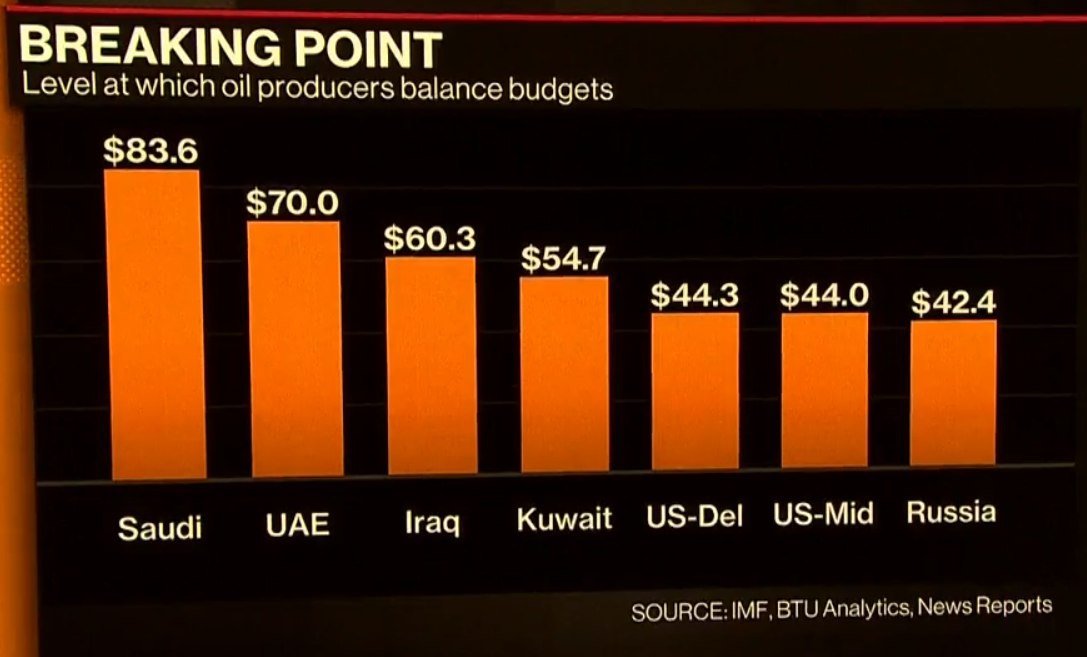$55-$60 US. The price at which U.S. shale producers can make money. Some companies have said that they would be fine at $50 and some even at $40 oil but the energy sector has seen investors frowning even prior to oil tumbling to the worst 1-day move since 1991 when the Gulf War began.

How much oil-rich nations require oil prices in order to balance their budgets. Russia can handle lower prices better than other countries. This must have played a role for their decision to not maintain a 3+ year agreement with OPEC to maintain supply cuts to prop up oil prices.
Russia was tired of USA growing its market share during that process.
Back in 2014, I recall Russia and the Saudis pulling this stunt to no avail. In fact, that move backfired on them and this will be in their memory when the result was Shale producers increasing their efficiency and bringing down their cost to pump oil out of the ground by being forced to improve the technology of U.S. shale drillers.
So why did this occur? OPEC had come to a consensus, as well as 10 non-OPEC nations to cut production by 1.5 million barrels per day as long as Russia agreed to help out. OPEC, led by the Saudis, was to see the brunt of this cut around 1 million barrels, while Non-OPEC nations, led by Russia, would need to cut by around 500,000 barrels.
But what was different this time around was that on March 5th, the Saudi’s used an unorthodox method of bullying the Russians into being the last to agree to the cuts by making announcements through the media with aggressive language that there is no Plan B and that the OPEC production cut hinges entirely on Russia agreeing. What we are seeing is the aftermath of cornering the Russians. This is what happens if you place Vladimir Putin in a corner.
The Russians held steady. They are known for being ok with taking a hit and as long as others take an even larger hit they consider that a success. I estimate that Russia is losing over $100 million US per day.
It could be worth it for them as long as U.S. producers scale back production or even go bankrupt, but that could take months even if prices remain this low or lower.

You can see the extent of today’s fall in oil prices being the worst since 1991 when the Gulf War began. Traders will be holding onto their seats to see:
-Will governments step in with collaborative announcements of fiscal stimulus
-Will central banks save the day
-Will the -30% oil price drop (currently -22%) end the day around -15% or will prices continue to fall to a 2-handle with all the floodgates open as of April 1st.
Originally, OPEC+ had a deal to keep their previous cut of a couple million barrels per day which Russia initially agreed to extend as of April 1st.
That was before the Saudis pressured Russia for bigger cuts. Markets were told that there could be an additional 600,000 barrel cut, then a 1 million barrel cut, and finally the Saudis said all are onboard for a 1.5 million barrel increase to the previous cuts as long as Russia agrees.
So now Russia doesn’t even agree to the extension which they orginally said was ok as of April 1st.
With no extension as of April 1st, The Saudi’s are not only not cutting production on their own, they decided to INCREASE production. They are around 9.7 milllion per day now but have capacity up to 12 million. I expect them to pump around 11 million consistently because anything over this level will be not easy to maintain steadily. It is still enough to crash oil prices even further. Rosneft in Russia just announced that they will be pumping as much as they can come April 1st.
Saudi Aramco just announced that they will be pumping 12.3 million barrels per day which is even above their max capacity. With such supposed flooding they are clearly trying to keep oil prices as low as they possibly can.
This oil price drop is affecting equities market as well as oil companies prices are dropping which exacerbates the market plunge of March 10.

